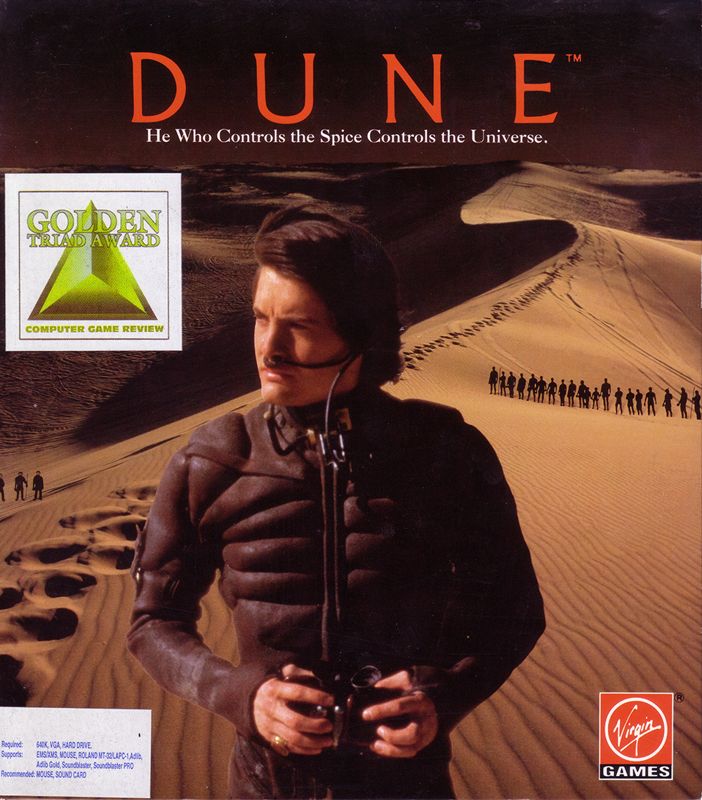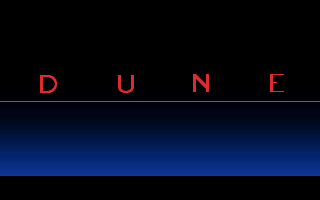I know that I hark on about licensed games not being very good, but the truth is that there are some really good licensed games out there. And today, we’re going to review one such game based on a movie I quite like (which is, by itself, based on a novel by Frank Herbert). I’m talking about Dune (based on David Lynch’s movie of the same name).
Dune is an adventure/strategy game developed by Cryo Interactive and published by Virgin Games. It was originally released in 1992 for the Commodore Amiga and DOS. It was re-released the following year in CD-ROM format for DOS and the Sega Mega-CD/Sega CD.
Production began in 1990 (despite Lynch’s Dune being released in 1984) after Virgin Games USA president, Martin Alper, was convinced by Philippe Ulrich and Jean-Martial Lefranc to employ Remi Herbulot and his new studio, Cryo Interactive, to develop the game. But 6 months after, Virgin wasn’t happy with the game’s development and threatened to cancel the project and pass it to Westwood Studios (who ended up making another videogame based on Dune).
But Herbulot and the rest of his team continued to develop their game in secret and in 1991, presented it to Alper, who was now very impressed with the prototypes and reversed the cancellation (although he still allowed Westwood Studios to finish their game). Cryo was able to beat Westwood Studios and released their game first. Several ports were also planned but only the Sega CD version was made.
But enough history and let’s look at the covers:

This is the original US cover and it’s simply a still image from the movie. But it’s a nice cover that conveys what the game’s about.

This is the original EU cover (based on one of the movie’s posters) and I prefer it over the previous cover. The 2 moons give the impression of an alien landscape.

This is the US CD-ROM cover and I also like it a lot. I particularly like the contrast between the desert and the water ripples. Very soothing.

This is the Sega CD cover and it’s an artistic depiction of the movie. While Paul’s portrait and the sandworm aren’t bad, the Fremen portrait underneath it is average at best.
But enough with the covers and it’s time to awaken this sleeper:
The game starts with an intro consisting of a collage of several of the game’s animations and cutscenes, accompanied by a nice music theme. Then after the credits, another small intro explains the backstory: you play as Paul Atreides, whose noble family recently moved to Arrakis to mine the spice, the universe’s most important resource. But you also need to deal with the Harkonnens, a rival clan, with the help of the local natives, the Fremen.
The CD-ROM version expands the intro even further by adding the movie’s intro, with Princess Irulan (played by Virginia Madsen), doing the exposition. This extra intro, on top of the original intro, makes it one of the lengthiest intros I’ve ever seen in a video game.

The game then properly starts in the main room of the Atreides palace, where you see a couple of guards, some sort of throne and Paul’s father, Duke Leto Atreides. The entire game is played from a 1st-person perspective, with the main view occupying the majority of the screen with a bar on the bottom. In this bar, you’ll find an encyclopedia on the left and underneath it, an icon that depicts the day-night cycle and the number of days passed, along with 2 empty boxes, which are the companions’ icons (more about this later).
In the middle of the bottom bar, you’ll find a box with several options (the main map, any available character to speak, the game’s options, etc.) and on the right, all the available directions you can go to. You can travel in any of the four cardinal directions (north, east, west and south) to another screen.

After talking with Duke Leto (who gives a bit more exposition and a couple of hints to progress), go north to Paul’s room. Here, you can look at the mirror (which shows Paul’s reflection). While looking at the mirror, you can access several of the game’s options, including the save and load feature. Yes, you have to access Paul’s room every time you want to save and load, which can be problematic if you are on the other side of the planet. Luckily, Arrakis isn’t that big and you always have to return to the palace to trigger several of the storyline’s events, among other things. And after a while, you’ll hardly need to travel (except for very specific events).
One of the first objectives in the game is to look for sietchs in the desert (by using an ornithopter to travel) and recruit Fremen tribes to initially mine spice (and later train them for war and more). Like I said before, you later need to get back to the palace to send the spice to the Emperor (or he’ll get mad and kick you out of the planet) and to advance the story along. But later on in the game, Paul’ll awaken his powers and he’ll be able to contact the Fremen telepathically across the planet.

You can also travel with 2 more companions, which you can talk to and learn more about the planet, the Fremen and the rest of the characters. Most of these companions will come and go as the story progresses (although Stilgar will accompany Paul throughout most of it).
The moment you recruit a Fremen tribe, you can order them around the planet at will and assign them several different tasks, including attacking enemy fortresses (but be careful, because the enemy can also attack your sietches). The battles are in real-time and if you travel to a battle when it’s happening, you can even watch it. You’ll also need to find dealers to buy new weapons and vehicles for your troops.
The story is more or less faithful to both the movie and the novel with some of the character portraits based on the actors’ likeness, like Kyle Maclachlan as Paul Atreides. But even with the strategy sections, one can finish it in a day or 2.
Now to the technical aspects: The graphics (especially the colours) are beautiful, although the animation is very limited. But the music is probably the best part of the game. The soundtrack is just great at creating atmospheres, whether you’re travelling through the desert or watching a battle in real time. The sound effects are also good, although there aren’t many of them. The CD-ROM version added an even better soundtrack, expanded cutscenes and digitised speech. But the quality of said speech isn’t very good, from the low volume to the stilted voice-over acting.

The mouse-based controls are very intuitive and responsive along with the UI itself, although there might be some confusion due to the variety of maps available.
In conclusion, Dune is actually a good game with a great soundtrack, atmosphere, characters and story. But the adventure/strategy mix isn’t very homogenous with only light mechanics from each genre that pop up individually throughout the gameplay. Therefore, it’s a recommended title, especially for gamers who want an easy experience to get into.
I haven’t played the Sega CD version but the Amiga version is just like the original DOS version (albeit with better music quality).
Shortly after in the same year, Westwood Studios released their game, Dune II, which overshadowed this game by creating the RTS genre and influencing all the strategy games afterwards (including other Dune videogames), but that’s a review for another day.
I hope you’ve enjoyed this review and I also hope you’re enjoying the new Dune movie that’s currently in cinemas. See you around and remember to awaken the sleeper to keep on playing.

Are you absolutely sure that you can only save the game using the mirror?
It’s been a very long time since I last played the game, but I had the feeling that you could also save on the planet map.
LikeLike
I’ve been told that before but I only saved using the mirror. Thx anyway
LikeLike
Okay, I’ve tried out the game yesterday on a Czech emulator website, unfortunately, the savestates turned out to be unrecoverable after exiting the session, pretty much forcing me to do the whole thing in one go which I obviously didn’t. I looked for desktop-based emulators and while I got one of them to work eventually, I was put off by the different music, so much so that I really didn’t want to keep going. I couldn’t Google any 100% confirmation for that, but by now I am almost certain that what I played yesterday was the original dialogue-free DOS release and the other thing I tried out (which also called to input a manual page number upon startup), also without dialogue, must have been the Amiga port. Therefore, the music version which I really wouldn’t want to do without further down the road must have been Adlink, whereas Amiga apparently came with Roland MT-32 (fine in its own right, but I just have the former earwormed permanently, it seems). There are other differences between the two, the visuals are different (the dialogue text box being beige in DOS and light blue in Amiga).
If anybody can validate my suspicions, I’d be grateful. I also assume that both the PC and Sega-based CD versions are identitcal.
LikeLike
Hello.
When I was playing the game for the review, I played it on Dosbox-X and I couldn’t load my save file. I tried again on regular Dosbox and it saved well.
I haven’t played the Amiga port enough to see major differences between that one and the PC port.
And yes, AFAIK the PC CD-ROM and Sega CD versions are similar.
LikeLike